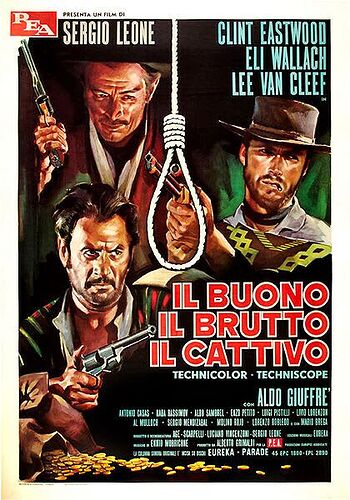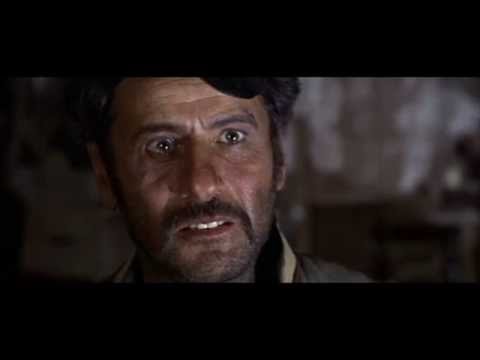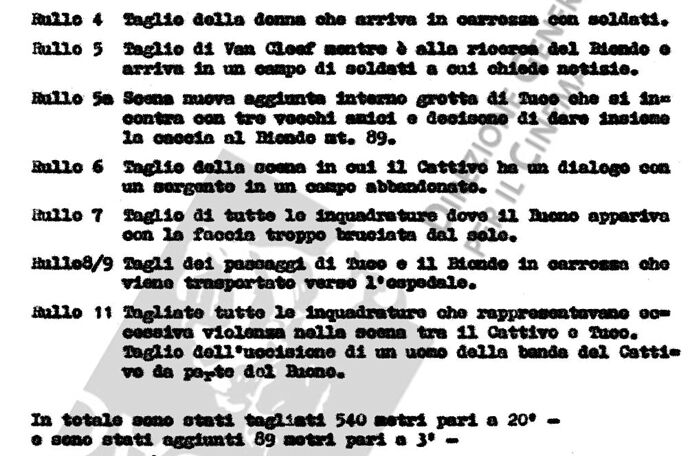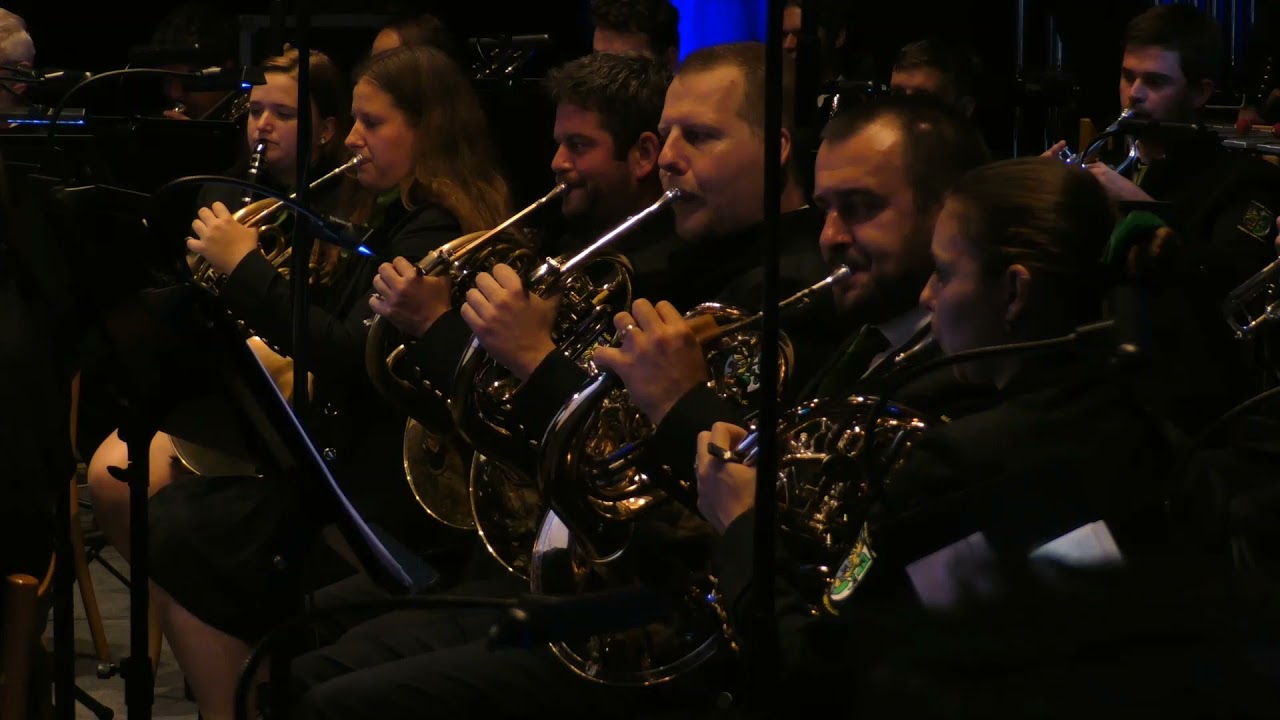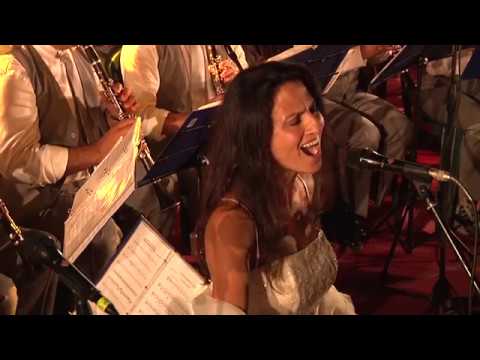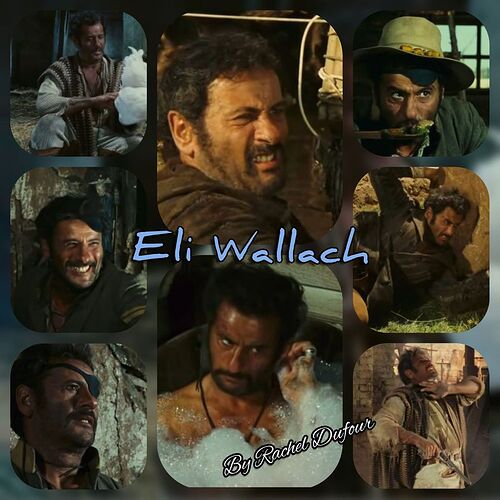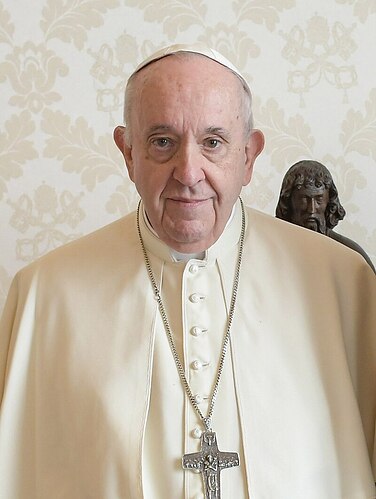Agreed…I love both though, apart from the grotto scene of course. I still think we should be able to have the version Leone himself intended that said. Could you elaborate on which restored scenes you particularly like?
The most I like the further scene with the drunk Captain at the bridge, that one I really love, especially when he asks them about their names.
Then the scene with Sentenza at an Confederate outpost, that one is good for the film’s inner rhythm. But also not necessary for the film’s continuity.
I think these 2 are the ones that really should be in.
Apart from the desert scene I’m also not exactly sure if the film runs better with or without the short scene with Eastwood and Wallach after they leave the mission, just before they get arrested.
But the desert scene is good in itself.
And of course, we should be able to have the version that Leone himself had prepared, and that’s the Italian version, which means the long version without the grotto scene and with the complete torture scene. 35 mm copies of that version exist, some fans have an IB print of that.
Very much enjoyed this which I watched last weekend, always has been an absolute classic to me. I watched it very regularly on VHS quite some years back!
First time seeing the extra scenes which reading back here, are on the go for quite some time. Enjoyed Van Cleef in the fort/hospital but the rest could go. Indeed the cave/grotto scene with the chicken is just poor, and the guys descending down on the ropes is just cartoonish.
Magic soundtrack.
There are some slightly far fetched bits, coincidences, but hey, it’s just an all time great.
5 star.
As well as humanising Tuco, the Padre Ramirez scene also subtly humanises Blondie. I like the way that he witnesses their altercation, but quickly ducks away so that Tuco won’t know he’s seen him fight with his brother. Then, when Tuco is going on about how much his brother loves him, Blondie keeps quiet and just offers to share his cigar. I love that little scene, there’s so much in it - all underpinned by Morricone’s beautiful music of course…
Hmm, for me this scene does not humanise Tuco.
He’s just his usual asshole self. He only wants that his brother forgives him his selfishness, he is not honest to him, and when he realises that his brother looks throgh his lies, that he does not want to ease his guilty conscience, he just becomes brutish again. Yeah, he feels bad for a short moment, but only for himself, not for his former actions.
Great observation, and thoughts there, Extranjero. ![]()
Personally, I’ve always loved the Tuco/Father Ramirez scene…for it deals with the different paths that family members can take in life. Reconciliation doesn’t always happen, but its still good to see 'blood; try to make up - if only for the wrong reasons - or what others perceive as selfish intentions…
Upon finding out that his brother (Luigi Pistilli) was in charge at the Monastery, Tuco didn’t have to go seeking him out. He could have just said ‘Sod it!’, and kept a low profile.
No. Instead, he, I believe, felt the inward desire to ‘make-up’ with the remaining vague memories of his turbulent past (even if he wouldn’t admit that even to himself).
After all, Tuco had absolutely nothing to gain by choosing to meet with his brother, especially after an absence of so many years.
There is genuine emotion there when Tuco finds out that both his parents are dead.
Yes, it doesn’t change his life-style, but it does show the audience that even a ‘scoundrel’ has feelings. The acting of Eli Wallach and Luigi Pistilli speaks volumes about ‘lost years’ in this brief scene.
I think that - in their own way, and despite taking different roads in life - both brothers are angry inside, and secretly wish that early kinship as young boys could be rekindled.
Personally, there was a period when I didn’t contact my own four brothers for many years, and this scene always emotionally got to me upon viewing it. I am reconciled to them all now, but that scene in ‘GBU’ reminds all of us that lost years really are lost forever.
“And so, even a tramp like me, I know there’s a brother somewhere who will never refuse me a bowl of soup…”
But this doesn’t make him any less human, of course. ![]()
What the scene really does is reveal more of his character - after the hypocritical fawning over his brother, his reaction to news of their parents’ death, and his anger at being dismissed by Pablo, feel completely genuine. And there are those great little touches - the way he helps his brother up again after knocking him down, and briefly hesitates when Pablo calls after him - which make this such a beautifully-observed piece of human drama. I think it’s one of the finest scenes in the trilogy.
Agreed. ![]()
I had a look at the Italian censor submission from April 1969. This is actually a re-release version submitted to get an unrestricted rating not a 14 rating (as per the long article from 2015 states). GB&U was originally given a 14 rating uncut in December 1966.
Cuts of 20m have been made and, for reasons unknown, the Grotto scene has been back added to the film for this submission although it was not in the original Italian theatrical release of 1966. So, the Grotto scene was in a theatrical release at some time. This print is 17m shorter than the original Italian theatrical print.
Whoever edited this must have used the 161m International Print as a guide since the exposition deletions are the same scenes as cut from the International Print (e.g. the scene of The Bad visiting the Confederate Fort (R5/6 - although I am confused that there appear to be two cuts here), the nighttime scene in which The Good kills one of The Bad’s gang (R11) and Blondie and Tuco in the carriage on the way to the hospital (R8/9)).
However, this print makes extra cuts for the unrestricted rating. When the film was submitted in 1966, the censors had specifically flagged the desert scenes and the POW camp beating-up of the Ugly as justifying the 14 rating.
The extra cuts for the unrestricted rating are:
Reel 4 - Cut woman (Maria) arriving in cart with soldiers
Reel 7 - Cut frames where The Good appears with his face too burnt by the sun
Reel 11 - Cut all the shots that depict excessive violence in scene between The Bad and Tuco.
Unfortunately, that’s all the detail there is so one doesn’t know how the desert and PoW scenes were cut.
But, an interesting artefact.
Watched this more than 200 times ![]() I adored the role of Eli Wallach
I adored the role of Eli Wallach
we find a Tuco, humoristic as much as being a bad guy… Clint Eastwood was excellent as much as Lee Van Cleef
This movie is somewhat overlong. I’m going to make a fan-edit with some stuff removed.
Some scenes don’t quite work, especially in the extended version.
It’s weird also in the camp sequence, how can Angel Eyes just walk in and out of the army? Suddenly he is some kind of military officer and the next day he can just leave together with Blondie.
That he leaves is just deserting, but how he did manage to come not only as a Sergeant to the army, but also to the prison camp where he has the best chances to find Bill Carson, that only can be explained with a fortune spent in bribing, or with a genre in which gunfighters can get easily 20 shots out of their six-shooter …
That is another issue, that SW heroes can shoot like they do, it’s part of the SW rituals.
But this stuff with Angel Eyes in the camp is too far fetched storywise.
EDIT: Someone might argue that it’s also far fetched with the cannonball that saves Blondie from being hanged. Or that Tuco and Blondie happen to stumble upon the horse wagon with Bill Carson laying inside.
These are however different things, it’s pure luck or happenstance of course, but we get to another episode in the story, which is the point.
But that Angel Eyes can come and go as he pleases in an army, especially during war, that is not how it works.
Why don’t you just watch the international theatrical cut? It’s a lot better than the extended version.
To me even the international cut is too long, unfortunately.
It would have been nice to see this version preserved. The shortest version was apparently a 95-minute edit. I’d love to watch it just to see how hideous it is.
The Good The Bad and The Ugly and “too long” do not belong in the same sentence ![]()
